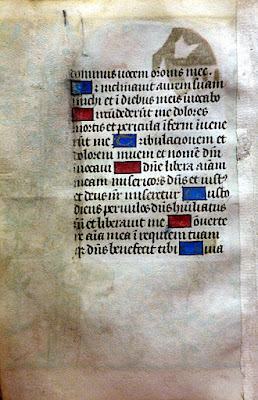In The Book of Hours of Louis De Roucy (RECEPTIO Academic Press, 2022), Rossi writes:
"What is noticeable in this manuscript, apart from the constant presence of owls in the borders, is the heraldic shield of its first owner. It appears with an unusual insistence, on average every ten pages, at least six times in the retrieved leaves, depicting a blue lion on a field of gold, Or a lion azure armed and langued gules (Fig. 8 et seq.)" (p. 22):
Figs. 8a-8f reproduce these six shields:
But in my blogpost here, I described the background as silver (argent) not gold (or), and note examples of French families that bore these arms:
I also provided a close-up detail of one example from the manuscript:In heraldry, when silver is unavailable to a painter or illuminator, white is the standard substitute. When either lead-white or silver is used (or another metal with a silvery appearance), it has typically oxidised to a metallic grey or black. Gold, in contrast, does not oxidise.
In the "de Roucy" Hours, there are a couple of cases where the background of the arms do look somewhat gold, but when compared to the gold of the borders, it is immediately apparently that they are different, which suggests that the background of the arms are, in fact, not gold:
This may be analogous to the case of the famous dress which looked black and blue to some people, but white and gold to others [Wikipedia]: essentially, a person's colour-perception is influenced by the ambient light in which they view an image.
Also, in the case of the "de Roucy" manuscript, we are reliant on mostly relatively low-quality images, not the originals.
But there is a piece of physical evidence that may settle the issue. Where silver (or a silver substitute) is used, its oxidisation has caused dark strike-through on the other side of the leaf, as very clearly demonstrated, for example, by the row of arched windows in the background of the All Saints miniature:
 |
| Recto |
If we look at the Burial Service leaf (which has one of the heraldic initials), recto and verso, we can see that the silver roof-tiles of the building in the background have caused exactly the same sort of strike-through:
Note that, as usual, the gold of the borders does not cause strike-through. But if we look closely at the reverse of the heraldic initial, in the lower right corner of the text area on the verso, we see the telltale shield-shaped strike-through:
This provides clear physical evidence in support of my contention that the background colour of the heraldry is silver not gold (argent not or), and therefore that Prof. Rossi's identification of the patron of the manuscript is based on a misreading of the heraldry, and is therefore wrong. There is, in fact, no good evidence to suggest any connection with any member of the de Roucy family.









Nice work! I do love research where people look further than the basic, in this case the miniature. To understand you also must look at the back, at the sides (with bindings). Take another perspective and see if you're argument still holds. Thanks for this blog! Astrid
ReplyDeleteExcellent sleuthing! From MariaTeresa Penna
ReplyDelete